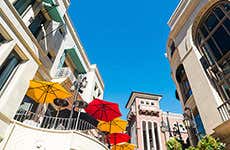
Griffith Observatory
The Griffith Observatory is not only one of the most famous astronomic observatories in the world, but it also offers incredible views of Los Angeles, from Downtown to the Pacific Ocean and even the Hollywood Sign.
History
The Griffith Observatory was inaugurated on 14th May, 1935 after almost 2 years of construction. It was funded by Griffith J. Griffith, who had already donated the land to the city a few years earlier. His aim was to make an observatory that could be accessible for the general public, rather than being reserved for scientists.
The observatory was used during the Second World War to train pilots in astronavigation, and during the 1960s it was used to train the astronauts of the Apollo programme.
As well as several telescopes, the Griffith Observatory houses a planetarium and various exhibitions. One of the most fascinating of these exhibitions is the Tesla coil which is lit up every hour to showcase one of the most important inventions of the 19th century.
An interesting fact for film lovers is that the observatory has also appeared in many films and television series, such as Rebel Without a Cause (1955), The Terminator (1984) and Transformers (2007).
Telescopes
The Griffith Observatory has a gigantic telescope through which you can admire the stars and planets up close (after waiting a while in the queue, of course!). At night, they also place smaller telescopes outside the building.
Visiting
The Griffith Observatory is not only a must-see but, according to the wish of its founder, it is also completely free. Parking, entry, telescopes, exhibitions... it's all free! What's more, as well as being a window to the stars, the Griffith Observatory has an incredible view of Los Angeles.
The only part that requires payment is the Samuel Oschin Planetarium, where there are 10 screenings a week. That being said, tickets are very affordable.










Schedule
Tuesday to Friday: from 12 pm to 10 pm.
Saturday to Sunday: from 10 am to 10 pm.
Mondays: closed.
Transport
Bus: Griffith Observatory, DASH Observatory.
Nearby places
Hollywood Sign (2.6 km) Walk of Fame (3.6 km) Ripley's Believe It or Not! (4.2 km) Dolby Theatre of Los Angeles (4.3 km) TCL Chinese Theatre (4.3 km)

